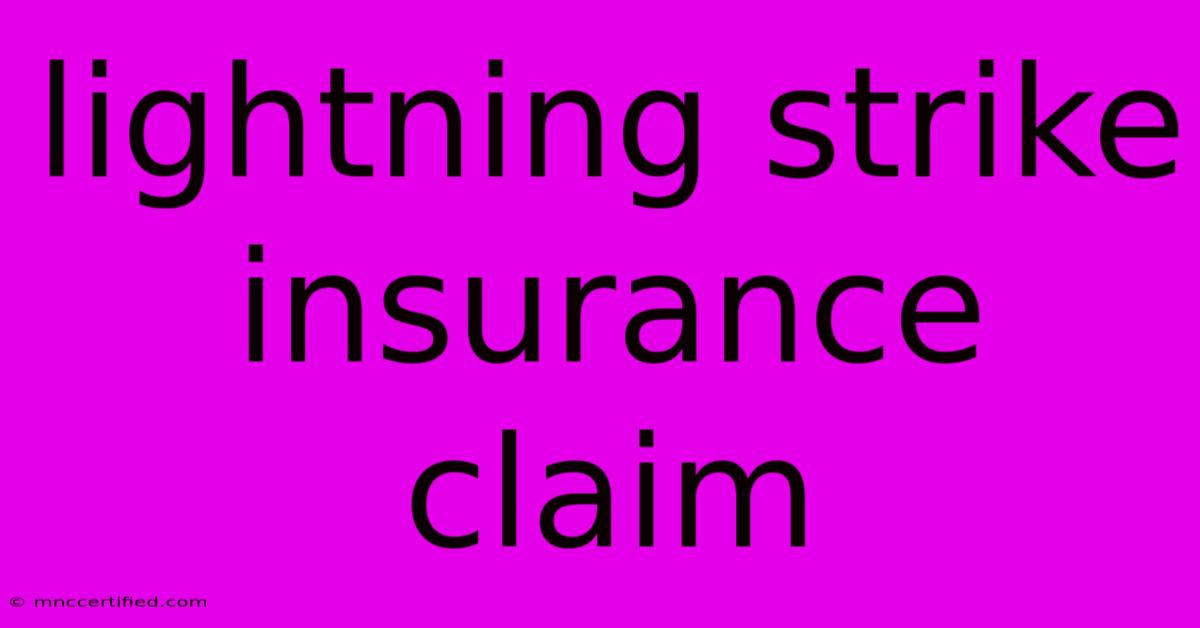Lightning Strike Insurance Claim

Table of Contents
Navigating the Lightning Strike Insurance Claim Process: A Comprehensive Guide
Lightning strikes are terrifying and can cause significant damage to your property. Understanding your insurance coverage and the claims process is crucial to minimizing the disruption and financial burden. This comprehensive guide will walk you through every step, from initial assessment to final settlement.
Understanding Your Coverage: What Does Your Policy Cover?
Before a lightning strike even occurs, familiarize yourself with your homeowner's or renter's insurance policy. Look for specific clauses related to:
- Electrical damage: This covers damage to appliances, electronics, and wiring caused by a surge in electricity from a lightning strike. Note that some policies may have sub-limits on this coverage.
- Fire damage: Lightning strikes frequently start fires. Your policy should cover fire damage to your structure and belongings.
- Water damage: Firefighting efforts often result in water damage. Your policy should cover this, as well as water damage from a ruptured water heater caused by the electrical surge.
- Structural damage: Direct lightning strikes can cause significant structural damage, including roof damage, cracked walls, or foundation issues. Ensure your policy covers these eventualities.
Important Note: Policies vary significantly. Review your policy documents carefully, or contact your insurance provider directly to clarify your coverage limits and exclusions. Don't assume anything – it's better to be safe than sorry.
What to Do After a Lightning Strike
Following a lightning strike, immediate action is crucial:
1. Ensure Safety:
- Check for injuries: Prioritize the safety of yourself and your family. Seek medical attention if necessary.
- Assess the situation: Do not enter damaged areas until you are certain it's safe. Turn off all power sources to prevent further damage or risk of electrocution.
- Contact emergency services: If there's a fire or significant structural damage, call your local fire department and emergency services immediately.
2. Document the Damage:
- Take photos and videos: Thoroughly document all damage to your property, including both interior and exterior damage. Capture images from multiple angles.
- Make a detailed list: Create a detailed inventory of damaged items, noting their make, model, and estimated value. Include receipts or purchase records if possible.
- Keep records of all communication: Note down the date, time, and content of all communication with your insurance provider, contractors, and other relevant parties.
3. Contact Your Insurance Provider:
- Report the claim promptly: Contact your insurance provider as soon as possible after the lightning strike. Follow their instructions carefully regarding reporting procedures.
- Provide necessary documentation: Be prepared to provide them with the photos, videos, and inventory list you've created.
The Lightning Strike Insurance Claim Process: A Step-by-Step Guide
- Initial Claim Report: File your claim promptly, providing all relevant information and documentation.
- Insurance Adjuster Visit: An adjuster will inspect the damage to assess the extent of the loss and determine the payout. Be prepared to answer their questions and provide any additional documentation they request.
- Negotiation and Settlement: The adjuster will provide an offer based on their assessment. You may negotiate this offer if you believe it's insufficient. Understand your rights and be prepared to support your claims with documentation.
- Repairs and Reconstruction: Once the claim is settled, you can proceed with repairs and reconstruction. Choose reputable contractors and ensure all work is documented.
- Final Payment: After repairs are completed (and inspected, if required), the insurance company will release the final payment.
Tips for a Smooth Claims Process:
- Maintain good communication: Stay in regular contact with your insurance provider and keep them updated on your progress.
- Obtain multiple quotes for repairs: This will help ensure you receive fair compensation.
- Keep all receipts: Maintain meticulous records of all expenses related to the claim.
- Consider professional help: If the damage is extensive or the claims process is complex, consider seeking assistance from a public adjuster.
By understanding your insurance policy and following these steps, you can navigate the lightning strike insurance claim process efficiently and minimize the stress associated with this unforeseen event. Remember, preparation and clear documentation are key to a successful claim.

Thank you for visiting our website wich cover about Lightning Strike Insurance Claim. We hope the information provided has been useful to you. Feel free to contact us if you have any questions or need further assistance. See you next time and dont miss to bookmark.
Featured Posts
-
Bondo All Purpose Putty 1 Gallon
Nov 21, 2024
-
Idaho Commercial Truck Insurance
Nov 21, 2024
-
Peacock Free Trial With Spectrum
Nov 21, 2024
-
Suits La Cast Shake Up Revealed
Nov 21, 2024
-
Farm Bureau Insurance Gaylord Mi
Nov 21, 2024